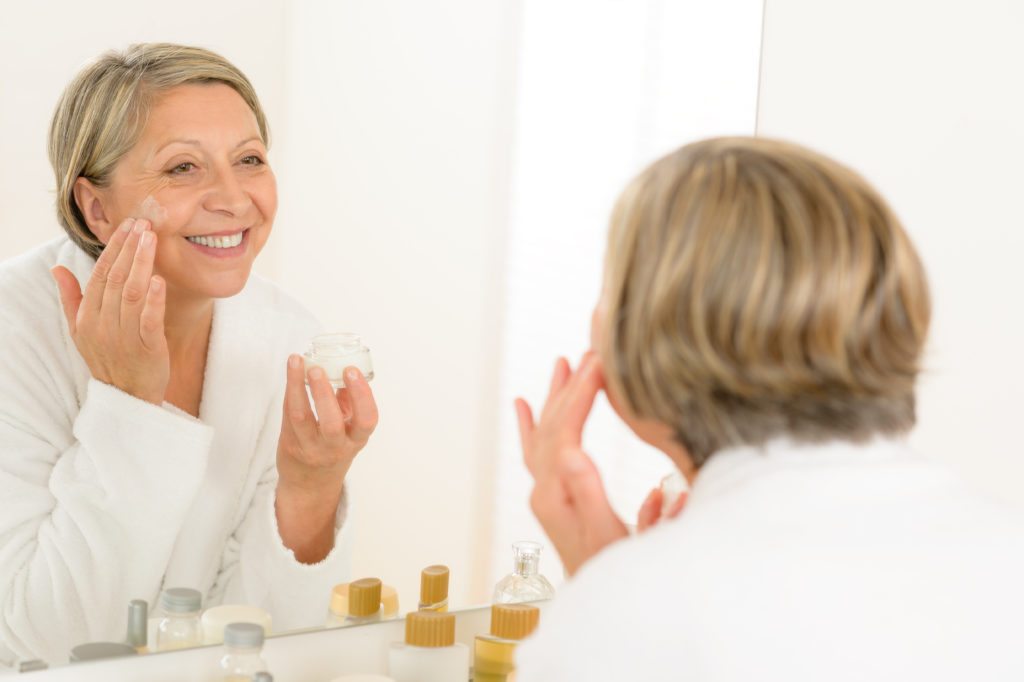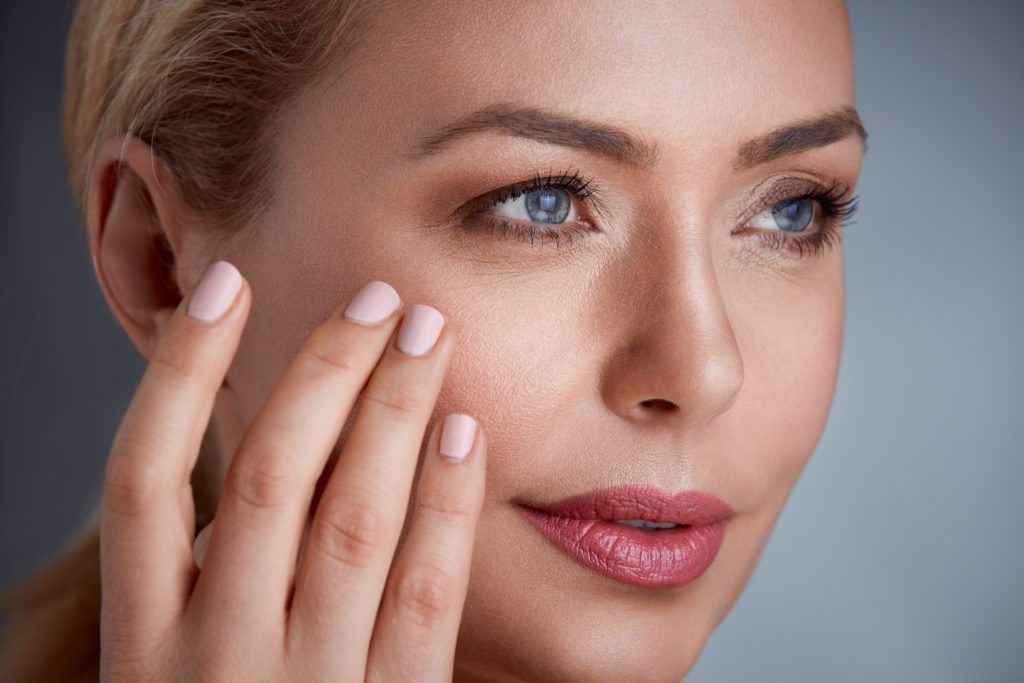Fine lines and wrinkles are a natural part of the aging process. As skin loses its elasticity and years of sun exposure accelerate the aging process, many skin care clients start to notice rough skin, dry patches, and wrinkles. Retinols and retinoids show promise in preventing and even reversing some of the effects of aging. If you want to promote skin health for people of all ages, understanding retinols and retinoids is a great place to start.
Retinols
All retinols are forms of vitamin A, which occurs naturally in skin. You’ll see this ingredient in many over-the-counter products, usually in concentrations of less than 1%. When applied topically, enzymes in the skin convert this vitamin derivative into retinoic acid. According to West Lake Dermatology, retinoic acid “is clinically proven to improve lines, discoloration issues, and revitalize the skin.” Retinols on the other hand are much weaker than prescription retinoids, but they’re still very effective for many clients.

Retinols vs. retinoids: what’s the difference?
Retinols are typically available over-the-counter or via estheticians, making them easily accessible for consumers. Low concentrations and easy topical application makes them a great starting point for reversing the signs of aging and promoting healthy skin. Unlike fast-working retinoids, retinols usually require regular use over 3-6 months before clients see more significant results. However, you don’t need a prescription to buy a retinol product, and they are typically less costly for the consumer.
Who should use retinols?
Retinols are a great starting point for clients who have never used Retin-based products. Their low price and over-the-counter availability provide access for many clients. In addition, those who experience retinoid side effects typically experience less irritation with retinols.
Benefits of Retinols
- Lower-strength formula produces fewer side effects
- Low cost
- Over-the-counter availability

Proper use of Retinols
Apply retinols topically and regularly for best results. It takes two to three weeks to start converting retinol into retinoic acid. Don’t expect results for three to six months.
Follow directions
It’s best to consult a professional to customize the concentration that works best for you. This is especially important for those who experience side effects from retinoids. Don’t skip applications unless you experience side effects, and wait at least three to six months for retinols to start improving your skin.
Use a thin layer
Since retinols require metabolic processes to convert them to retinoic acid, a thin layer is best. Spread the product evenly over your skin in a thin layer. Use gentle, upward movements when you apply.
Wear SPF

Sun exposure quickly worsens the effects of aging, so anyone using a retinol product must wear sunscreen. Excess sun damages the skin and can undo the effects of any retinol product. We recommend using a broad-spectrum sunscreen with an SPF 30 on a daily basis, year-round. Be sure to reapply throughout the day, especially when using retinols or other exfoliants.
Side effects
Retinols have relatively few side effects, but some clients experience skin irritation or chronic peeling. Reducing the concentration or trying a different form of retinol usually helps. Dryness and irritation can also be lessened by adding the retinol product to your moisturizer.
Contraindications
Users who experience severe side effects or allergic reactions should not use retinols. In addition, retinols may not work well for those with heavy wrinkles or extreme discoloration.
Pros and Cons of Popular Retinol Ingredients
Retinol
This ingredients requires two metabolic steps to produce retinoic acid, so it takes a little longer than other ingredients, like retinaldehyde. A relatively large amount of retinol must enter the cell before you’ll see positive changes.
Benefits
Retinol is relatively inexpensive. It’s available in various concentrations, so it’s easily to customize for individual needs. With regular use and correct concentrations, retinol works for many clients.
Side effects
High concentrations may irritate sensitive skin.
Bottom line
A good choice if you’re new to retinols or want to try an inexpensive product. For some clients, low concentrations won’t have an effect. For others, very high concentrations could irritate the skin. Get a professional consultation or expect some trial and error to get the results you want.
Retinyl palmitate
This ingredient requires an additional metabolic step, so it may take longer than retinol to produce an effect. Although retinyl palmitate is often cheaper than retinol, you’ll have to use a lot more to get the same effect.
Benefits
- Inexpensive
- Less irritating than retinol
Side effects
The side effects of retinyl palmitate are very rare, but you’ll see less skin improvement than you would with retinol.
Bottom line
This product is best for those who react badly to retinol or have very sensitive skin. Although it’s inexpensive, clients must use a lot to produce an effect.
Retinyl retinoate
This ingredient is a great option for those transitioning from retinols to retinoids, or who want a faster-acting product. Retinyl retinoate chemically combines retinoic acid and retinol to produce a stable, highly effective product with very few side effects.
Benefits
- More stable and long-lasting than other retinols
- Works faster than most retinols
- Few side effects
Side effects
This is a newer ingredient, and so far we’ve seen very few side effects. However, we don’t yet know a lot about the long-term effects of this product.
Bottom line
If you’re not sure whether to choose a retinol or a retinoid, retinyl retinoate is a great option. You’ll see faster results, a stable product, and minimal side effects. Since this ingredient is new, it’s typically harder to find.
Retinaldehyde
This ingredient is just one metabolic step away from retinoic acid, so you’ll see slightly faster results. You’ll also use less product. Although it’s more expensive than other retinols, it’s a good choice for some clients.
Benefits
- Use less product and still see positive changes
- Slightly faster than retinol or retinyl palmitate
- Closest readily available, non-prescription ingredient to retinoids
Side effects
Increased chance of skin irritation
Bottom line
If you don’t have sensitive skin and want to try an over-the-counter product that’s closer to a retinoid, this is a good choice. You’ll pay more, but the product is better understood than retinyl retinoate and is easily available.
For clients who want a relatively inexpensive, over-the-counter product, retinols are a great starting point. Their low concentrations don’t work for everyone, but they typically have fewer side effects than retinoids. Clients who want faster, more dramatic results should consider retinoids. Learn more about retinoids in All About Retinols and Retinoids Part 2: Retinoids.



